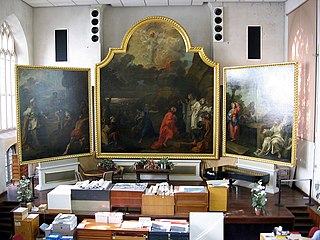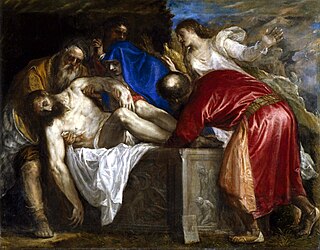 W
WThe Entombment is a glue-size painting on linen attributed to the Early Netherlandish painter Dieric Bouts. It shows a scene from the biblical entombment of Christ, and was probably completed between 1440 and 1455 as a wing panel for a large hinged polyptych altarpiece. The now-lost altarpiece is thought to have contained a central crucifixion scene flanked by four wing panel works half its height – two on either side – depicting scenes from the life of Christ. The smaller panels would have been paired in a format similar to Bouts's 1464–1468 Altarpiece of the Holy Sacrament. The larger work was probably commissioned for export to Italy, possibly to a Venetian patron whose identity is lost. The Entombment was first recorded in a mid-19th century Milan inventory and has been in the National Gallery, London, since its purchase on the gallery's behalf by Charles Lock Eastlake in 1861.
 W
WCaravaggio created one of his most admired altarpieces, The Entombment of Christ, in 1603–1604 for the second chapel on the right in Santa Maria in Vallicella, a church built for the Oratory of Saint Philip Neri. A copy of the painting is now in the chapel, and the original is in the Vatican Pinacoteca. The painting has been copied by artists as diverse as Rubens, Fragonard, Géricault and Cézanne.
 W
WEntombment of Christ is a c.1595 oil on copper painting by Annibale Carracci, now in the Metropolitan Museum of Art
 W
WThe Entombment of Christ is an 1820 painting by the French artist Eugène Delacroix, constituting a minor reworking of The Entombment of Christ, a c.1520 work by Titian. He left it to his pupil Paul Chenavard, who in 1881 left it to the musée des Beaux-Arts de Lyon, where it still hangs.
 W
WSealing the Tomb is a great altarpiece triptych by William Hogarth in the English city of Bristol. It was commissioned for St Mary Redcliffe in 1755. In the 19th century attempts were made to sell it, but it was given to the Bristol Fine Art Academy, which became the Royal West of England Academy. Its size made it difficult to display and it was rolled up and stored in the basement. In 1973 it was displayed in the ecclesiastical museum created in the war-damaged Church of St Nicholas. When the museum closed it was converted to offices; however the triptych remains in the building. It is on display to the public again after the church was re-consecrated in 2018.
 W
WThe Body of the Dead Christ in the Tomb is an oil and tempera on limewood painting created by the German artist and printmaker Hans Holbein the Younger between 1520–22. The work shows a life-size, grotesque depiction of the stretched and unnaturally thin body of Jesus Christ lying in his tomb. Holbein shows the dead Son of God after he has suffered the fate of an ordinary human.
 W
WThe Entombment of Christ is a 1513–1516 oil on canvas painting by Lorenzo Lotto, now in the Accademia Carrara in Bergamo. It originally formed the central predella panel to the artist's Martinengo Altarpiece at the church of Santi Bartolomeo e Stefano. The other predellas were Saint Dominic Reviving Napoleone Orsini and The Stoning of St Stephen.
 W
WThe Entombment is an unfinished oil on wood panel painting of the placing of the body of Jesus in the garden tomb, now generally attributed to the Italian Renaissance master Michelangelo Buonarroti and dated to around 1500 or 1501. It is in the National Gallery in London, which purchased the work in 1868 from Robert Macpherson, a Scottish photographer resident in Rome who, according to various conflicting accounts, had acquired the painting there some 20 years before. It is one of a handful of paintings that are attributed to Michelangelo, alongside the Manchester Madonna, the Doni Tondo, and possibly the The Torment of Saint Anthony.
 W
WThe Porto San Giorgio Altarpiece or Porto San Giorgio Polytpych was a 1470 multi-panel tempera and gold on panel altarpiece by Carlo Crivelli. Stylistically similar to Crivelli's Massa Fermana Altarpiece, the work was a fundamental step in his evolution away from the Paduan Renaissance towards a more delicate and realist style.
 W
WThe Deposition, also known as the Pala Baglione, Borghese Entombment or The Entombment, is an oil painting by the Italian High Renaissance painter Raphael. Signed and dated "Raphael. Urbinas. MDVII", the painting is in the Galleria Borghese in Rome. It is the central panel of a larger altarpiece commissioned by Atalanta Baglioni of Perugia in honor of her slain son, Grifonetto Baglioni. Like many works, it shares elements of the common subjects of the Deposition of Christ, the Lamentation of Christ, and the Entombment of Christ. The painting is on wood panel and measures 184 x 176 cm.
 W
WThe Entombment of Christ is a 1633–1635 oil on oak panel painting by Rembrandt. In 1783 the Scottish anatomist William Hunter bequeathed it to University College. Since 1807 it has hung in the university's art gallery, the Hunterian Museum and Art Gallery.
 W
WDeposition of Christ is an early 17th century painting by Jusepe de Ribera It was found on the altar of the Ara Pacis chapel in the co-cathedral of Castellammare di Stabia by count Vincenzo Coppola and donated by him to the bishop of the Diocese of Castellamare di Stabia. It is now in the Santissima Maria Assunta and San Catello Co-Cathedral in Castellammare di Stabia.
 W
WDeposition is an oil on canvas painting by Giambattista Tiepolo, one of his last works, produced in Madrid in 1770 less than a year before his death. It belonged to the Portuguese Pinto-Basto family for a long period and was bought in 2008 by the Museu Nacional de Arte Antiga in Lisbon, where it now hangs.
 W
WThe Entombment is a 1559 oil-on-canvas painting by the Venetian painter Titian, commissioned by Philip II of Spain. It depicts the burial of Jesus in a stone sarcophagus, which is decorated with depictions of Cain and Abel and the binding of Isaac. The painting measures 137 cm × 175 cm and is now in the Museo del Prado in Madrid. Titian made several other paintings depicting the same subject, including a similar version of 1572 given as a gift to Antonio Pérez and now also in the Prado, and an earlier version of c.1520 made for the Duke of Mantua and now in the Louvre.
 W
WThe Entombment of Christ is a c. 1520 painting by Titian, now in the Musée du Louvre.
 W
WThe Lamentation of Christ is an oil-on-panel painting of the common subject of the Lamentation of Christ by the Netherlandish artist Rogier van der Weyden, dating from around 1460–1463 and now in the Uffizi Gallery, Florence, Italy.